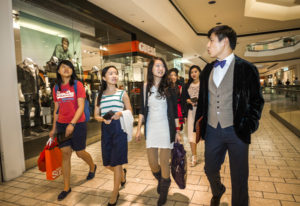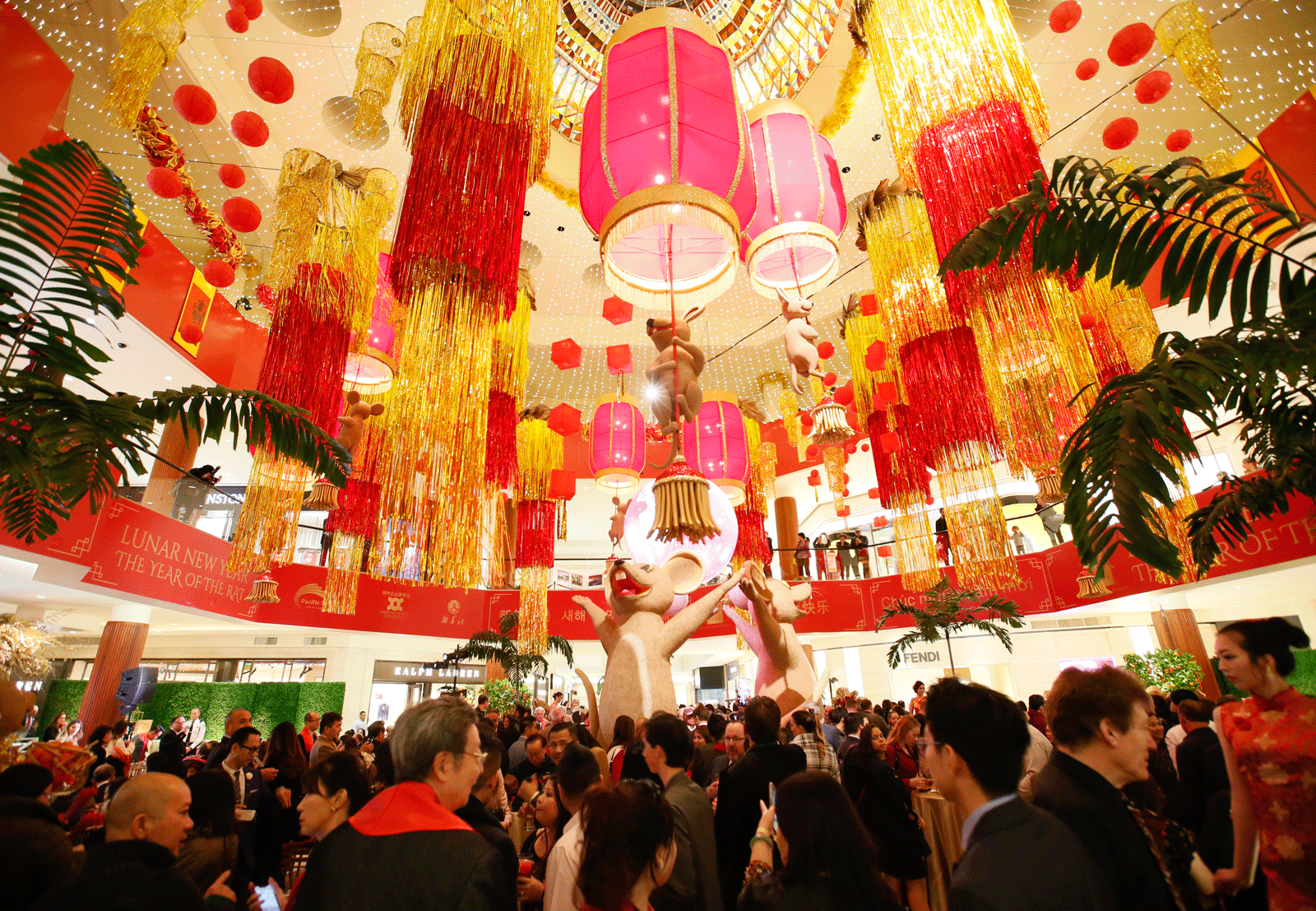
Decorated lavishly for Asian Americans and Chinese shoppers, South Coast Plaza Shopping Center opened its 18-day Year of the Rat celebration with a lavish party.
Sinitic cultures are famed for their hard work. From Shanghai to San Francisco, Singapore to Seattle, Chinese work hard so they can take 10 days off for at Chinese New Year. This week Chinese, Vietnamese and Koreans are celebrate the Year of the Rat, one of the zodiac symbols that define the 12-year cycle. This year the holiday is clouded by the Coronavirus that will quarantine some 40 million people in Central China and dramatically slow the country’s economy. Chinese living in affluent coastal provinces and neighboring Taiwan are not yet impacted by the virus and are free to fly to the US and spend money.
The China Outbound Tourism Research Institute says Chinese will make more than 7 million international trips this week. It will constitute the largest seasonal migration in history and every traveler crossing the Pacific will arrive in places like New York, San Francisco and Las Vegas and especially Los Angeles where they will confront large posters, banners and statues of gilded rats.
Welcome to the Year of the Rat. Kung Hei Fat Choy! Or Chúc Mừng Năm Mới if you’re Vietnamese celebrating Tet.
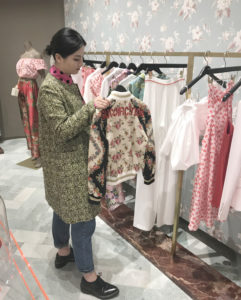
Mainland Chinese tourists like this woman at South Coast Plaza spend an average of $7,600 during their Chinese New Year holiday.
It’s not unusual for one country to embrace the holidays of another. Largely for commercial reasons, Christmas is widely celebrated in China despite President Xi Jinping’s admonition that party members must be “unyielding Marxist atheists.” But California’s acceptance of Chinese New Year has been rapid, overwhelming and color coordinated in red and gold.
If the U.S. West Coast has a new retail religion, South Coast Plaza in Costa Mesa, CA is Mecca and Jerusalem combined. A temple to haute couture located 45 miles south of Los Angeles, South Coast Plaza’s New Year celebration runs for 18 days. The centerpiece is a bejeweled display of dancing rodents in an Oriental garden festooned with ingots and gold coins over which hover an array of Chinese lanterns.
SCP does everything it can to make mainland Chinese fell right at home. Concierges at each of the plaza’s four entrances speak Mandarin or Cantonese, as do many sales people across its 251,000 sq. meters of retail space. Vietnamese and Korean also are spoken fluently in many of the mall’s 250 stores. Tourists from China already know the mall specializes in top brands like Harry Winston, Hermès and Gucci because of SCP’s extensive advertising on Weibo and WeChat.
“We began celebrating Lunar New Year ten years ago and understand how important it is to make it easier for Asian visitors to shop,” says Debra Gunn Downing, South Coast Plaza’s executive director for marketing. That’s why SCP provides complementary valet parking, a valuable perk in car-conscious California, and assistance from personal shoppers called “stylists” who will help discerning ladies assemble an ensemble.
With an annual GDP of $3.02 trillion, California’s economy, already the world’s sixth largest, increasingly is intertwined with East Asia. Los Angeles alone welcomes 103 nonstop flights every week and the number continues to grow as more of China’s second-tier cities establish service.
Over the past decade, travel from Mainland China to Los Angeles has increased 650%. More than 1.2 million Chinese traveled to the city last year and collectively they spent $1.6 billion – 23% of all international spending – on restaurants, hotels, entertainment and retail.
Chinese tourism is an economic windfall for the U.S. According to the U.S. Commerce Department, 3.24 million Chinese nationals visited the U.S. in 2018 and spent more than $35 billion while here. The U.S. Travel Association estimates that Chinese visitors spend an average of $7,600 per person during their vacation.
The first destination for the 1.2 million Mainland Chinese arriving in LA is the Beverly Center in West Hollywood whose 100 stores rival, if not surpass, those on Rodeo Drive. The Beverly Center supports LA’s “China Ready” program, which calls for businesses in the hospitality industry to employ Mandarin speakers, translate all promotional offers and informational materials into Chinese and accept China’s UnionPay credit cards.
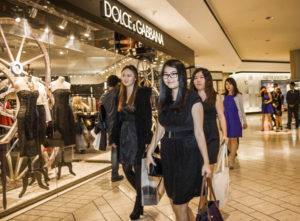
Merchandise from Apple, Louis Vuitton and Dolce & Gabbana costs much less in the US. Mainland Chinese avoid import and luxury taxes by buying three or four pof the same item.
During the Lunar New Year holiday the Beverly Center receives up to 50 buses a day packed with recently arrived Chinese ready to spend money. Five Mandarin speaking “brand ambassadors” use Weibo and WeChat to communicate with tour leaders before the buses even arrive. Since many Chinese only have an hour or so to shop, special concierges will escort shoppers to Apple, Louis Vuitton, Balenciaga and other stores they desire.
“We know from studying who walks through our doors that Chinese spend four times more than the average tourist,” explains Susan Vance, the Beverly Center’s director of marketing and sponsorship. “Often they buy multiple items of the same product and spend well into the six figures.”
Big spenders are immediately rewarded with red envelope gift cards, $50 for every $1,000 spent and $25 for a $500 purchase.
The Beverly Center makes extensive use of Chinese social media and is regularly attends the ITB Travel Trade Show in Shanghai. Its savviest move, however, is establishing friendships with Chinese students at UCLA and USC, who bring their parents shopping when they visit Los Angeles.
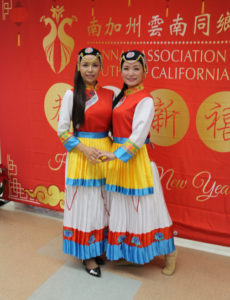
Photo by Scott Busby Colorful dancers in Hilltribe costume add color and song to Los Angeles’ Chinese New Year celebrations.
A wide array of businesses employ “China Ready” programs. Universal Studios offers Mandarin tours of its sound stages and movie sets. The Getty Museum experienced a noticeable increase in Chinese arrivals after it offered basic Mandarin instruction to its docents and began distributing Chinese language maps and audio guides.
Wealthy people on holiday appreciate a bargain, which is why the Lunar New Year period is the busiest time of the year for the Desert Hills Premium Outlets. Why would busloads of Chinese drive into the Sonora Desert 88 miles east of Los Angeles? Probably not for the Lion Dance. It’s because brand name items like Jimmy Choo high heels and Michael Kors watches sell for 25 to 60% off already discounted prices.
Despite being a country where only10% of the population have passports, China ranks as the world’s leading outbound travel market. But even without overseas visitors Chinese New Year already is a major event in Southern California, where tens of thousands of people spend the week eating Taiwan pineapple cakes and giving red envelopes called hongbao stuffed with cash to friends and relatives.
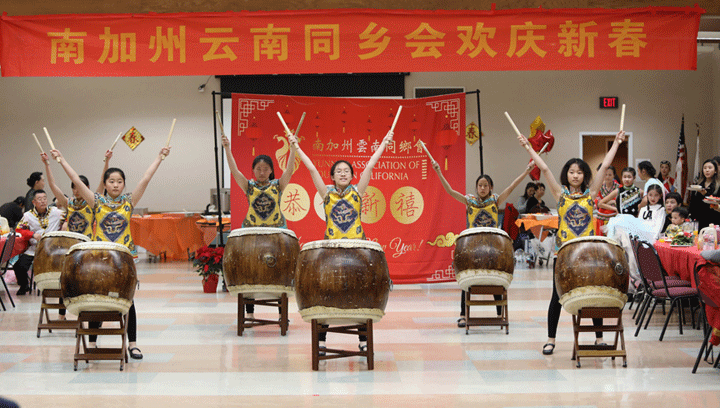
Yunnan Association of Southern California welsomes Year of the Rat with commmunity potluck and dancing.
It’s not unusual for one country to embrace the holidays of another. Largely for commercial reasons, Christmas is widely celebrated in China despite President Xi Jinping’s admonition that party members must be “unyielding Marxist atheists.” But California’s acceptance of Chinese New Year has been rapid, overwhelming and color coordinated in red and gold.![]()


